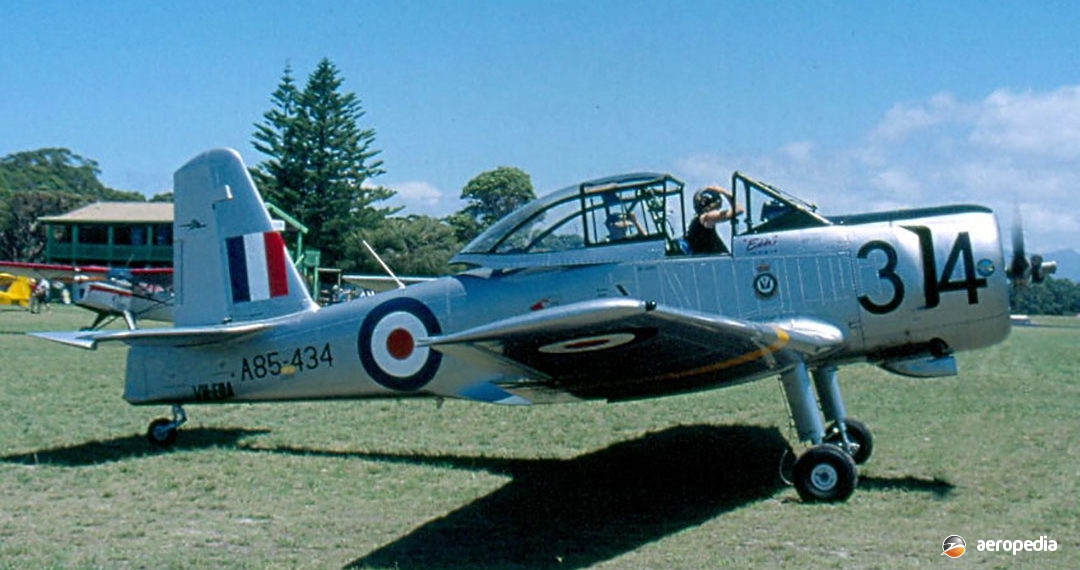Photograph:
CAC CA-25 Winjeel A85-434 VH-EDA (c/n CA25-34) at Moruya, NSW in January 2002 (David C Eyre)
Country of origin:
Australia
Description:
Three-seat basic military trainer
Power Plant:
One 332 kw (445 hp) Pratt & Whitney R-985-AN-2 Wasp nine-cylinder air-cooled radial engine
Specifications:
Armament:
Offensive nil; twelve US M18 target-marking smoke-generating grenades
History:
The CAC CA-25 Winjeel (an Aboriginal word meaning young eagle) was designed to meet a 1948 specification for an aircraft to replace both the de Havilland DH.82 Tiger Moth and the CAC Wirraway in RAAF service. It was intended to be of simple but robust construction, with economic operation and maintenance, and seating three persons.
The response by the Commonwealth Aircraft Corporation (CAC) was for a low-wing monoplane powered by a Pratt & Whitney R-985 Wasp radial engine, seating being provided for two, side-by-side. An order was received in May that year for two prototypes. However, various testing, manufacturing, and learning procedures meant that the first of these A85-618 did not fly until 3 February 1951, the second A85-364 following in July 1951. The type then proceeded to production as the CA-25 and each was powered by the Pratt & Whitney Wasp radial engine.
Extensive and prolonged trials were held in conjunction with the RAAF’s Aircraft Research and Development Unit (ARDU) at Laverton, VIC. However, the design did not initially meet air force requirements, as it was extremely difficult to induce the aircraft to spin, a feature necessary in a military training aircraft. Consequently the position of the fin was changed, and a dorsal fairing and a larger rudder were fitted. Both prototype aircraft were allotted to ARDU for service performance testing.
Final Government approval for the production of 62 aircraft did not take place until September 1953, the first production aircraft flying in February 1955. Further development led to an additional tail modification, which resulted in a taller fin and deletion of the dorsal fairing. A re-designed engine cowling was also incorporated.
The second prototype embodied a number of modifications and, in 1952, it was modified to take the 336 kw (450 hp) Commonwealth Aircraft Corporation Cicada radial engine of indigenous design. It was proposed to install this engine in the 31st and subsequent production aircraft but in the event development of this engine was cancelled, and thus all 62 production Winjeels, the first of which, A85-401, flew on 23 February 1955, were fitted with the Pratt & Whitney Wasp unit. The first aircraft was delivered to the RAAF on 16 September 1955, and the last production aircraft A85-462 was delivered to the RAAF early in 1958.
The Winjeel operated with No 1 BFTS (Basic Flying Training School) at Uranquinty, NSW. They operated with that unit alongside the CAC Wirraway. In December 1958 Uranquinty was closed and pilot training was transferred to RAAF Point Cook, VIC. The Winjeel continued in service at Point Cook and continued as the RAAFs ab initio trainer until the type was retired in July 1977.
Courses at Point Cook included pilots for the RAAF, the Australian Army and the Royal Australian Navy.
A number of Winjeels were attached to the Central Flying School (CFS) at East Sale, VIC, where senior instructors were taught to train instructors. Two (A85-439 and A85-450) spent many years with No 1 Air Trials Unit operating out of the Weapons Research Establishment (WRE) at Woomera, SA, where, apart from being used for transport work, they flew over the Rocket Range searching for the remains of rockets after launches.
Following the introduction of the AESL CT-4 Airtrainer as the RAAF’s ab initio trainer, most Winjeels were retired. However, after the introduction of CT-4 aircraft into service, the Winjeel continued in service to train Forward Air Controllers (FAC) for service in Vietnam, four Winjeels being modified for this role in March 1969. They were initially operated by No 2 Operational Training Unit (OTU) at Williamtown, NSW but in March 1970 they became No 4 Flight, later in 1987 coming under the wing of No 77 Fighter Squadron as “D Flight”. In January 1989 they became “C Flight” with No 76 Squadron which, at the time, was operating the Macchi MB-326 in the fighter / ground-attack role. The Winjeels continued in service until replaced by two Pilatus PC-9s and were auctioned in October 1995. Thus the Winjeel had a service life with the RAAF of 40 years.
In 1957 the two prototypes were allotted to RAAF Base, Wagga Wagga, NSW for use as instructional airframes, and these were later transferred to the RAAF Museum at Point Cook for display. First Winjeels disposed of were sold in May 1970, with nine airframes becoming available. In May 1979 a further eight aircraft were made available.
After retirement a number were scrapped, but others were obtained by warbird enthusiasts and restored to airworthy condition. They became very popular, with a display team of five aircraft being formed, based at Point Cook. Others were held in private collections or in museums.
In the mid 1990s eight Winjeels, which had been used by the RAAF School of Technical Training at Wagga Wagga, were sold to private operators. Some 31 have appeared on the Australian Civil Aircraft Register.
Two, VH-WHZ/A85-404 and ZK-JJG/A85-445, found their way to private operators in New Zealand, the former being registered ZK-WJL. However, in April 2017 this aircraft returned to Australia where it became VH-NSJ³. One VH-MMR (c/n 25-19 – A85-429) was exported to the United States in October 2004. Another, A85-449, was presented to the New Guinea Government for placement in a museum.

